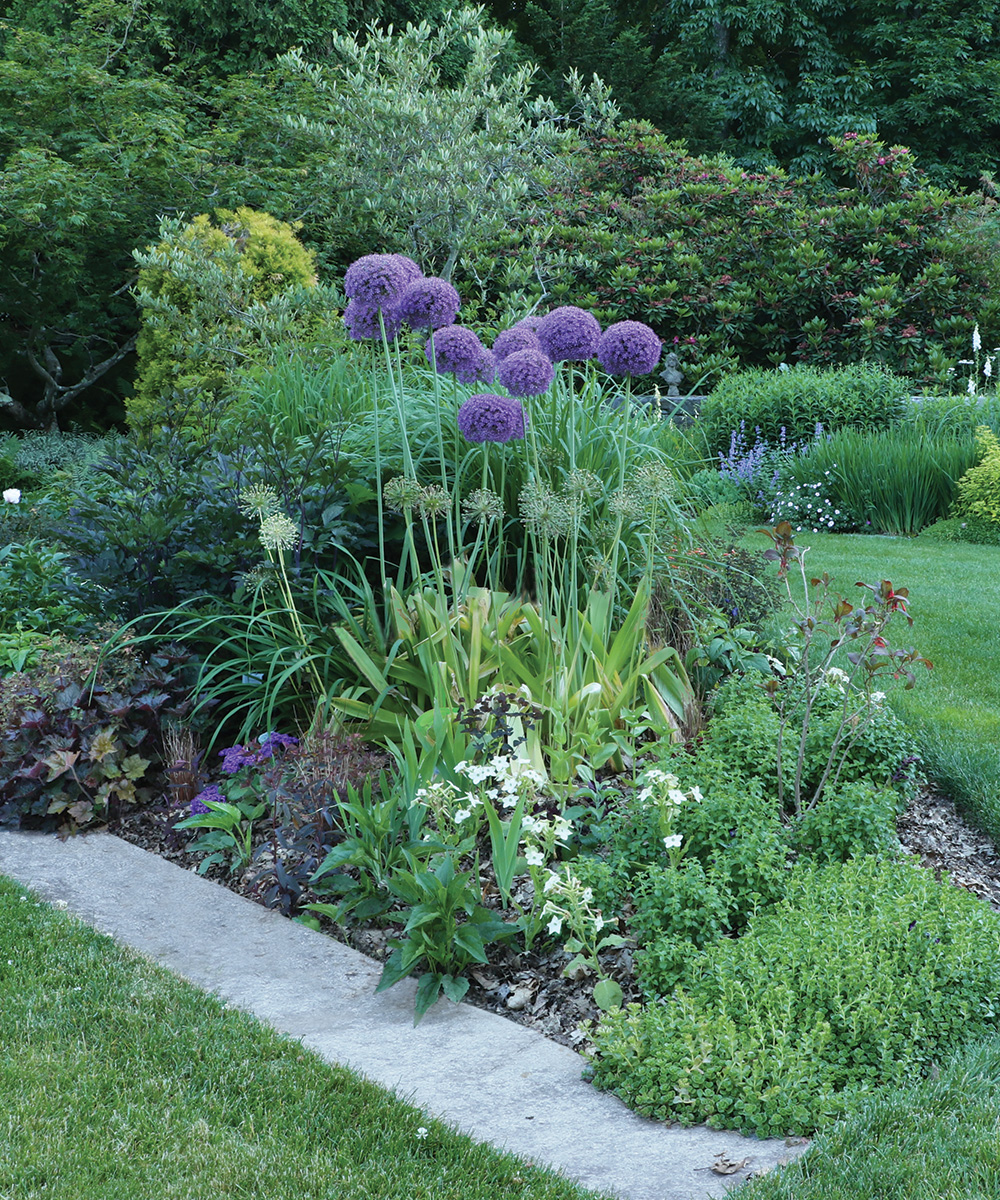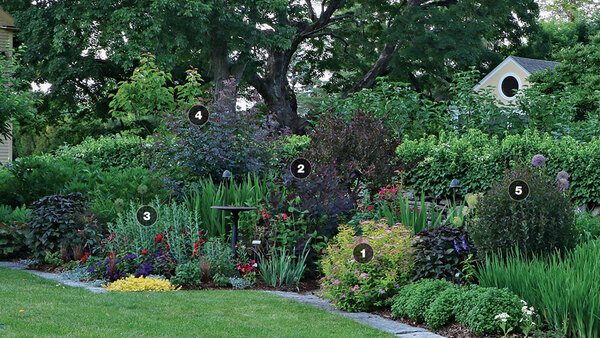
I first met Shirley Williams in 1994 while attending a landscape-design charette. These classes were conducted at several of the participants’ home gardens, including at Brigham Hill Farm, where Shirley and her husband, Peter, lived. Since then, I have had the privilege of engaging in a creative collaboration—designing, building, and planting many gardens that beautify their historic landscape. The farm is the setting for their hilltop home, an eighteenth-century Georgian colonial in North Grafton, Massachusetts. They are enthusiastic gardeners, charitable land preservationists, and generous garden hosts to many regional, national, and international horticultural institutions.
In 1997, Shirley and Peter asked me to create a new landscape design for an area that had formerly been planted with vegetables. This garden space occupied a large rectangle, 70 feet wide and 90 feet deep. Three sides of its perimeter were enclosed by fieldstone walls and outlined with borders edged with granite curbing. The fourth side was open and faced an elegant, elliptical-shaped swimming pool set approximately 12 feet away and not aligned with the middle of the rectangular space.
The layout certainly had its challenges, but I decided to use them to uncover my design direction. Protractors, compasses, and T-squares are typical tools of the trade when planning gardens. But beyond using those tools, a studied understanding of the underlying intrinsic value of geometrical forms is key to making an engaging landscape. Using the existing walls and pool as references, I used motifs of circles, angular beds, and layers of sensational plants to create a cohesive space that is still exciting and full of surprises.
A geometric approach offers clarity
After the pool and the bosquet of trees were made the center of the garden, the beds beyond were configured using radial lines to balance out the space. The zigzag and straight lines of the borders convey dynamic movement through the garden. Toward the back, more circles appear in the lawn space outlined by curved beds and a raised bed that contains the moon garden. The shapes of the island beds echo the arcs of the circles and the straight lines of the garden’s perimeter. This garden is a dynamically interesting space to explore. An aerial view makes the landscape’s geometric backbone obvious. See the planting plan with plant IDs.
Key
- Pool
- Bosquet of trees
- Zigzag bed
- Angular island bed
- Rounded island bed
- Curved gravel pathway
- Seating area
- Raised-bed moon garden
A harmony of circles, arcs, and curves unifies the landscape
The closeness of the elliptical swimming pool to the walled, rectangular garden space could not be ignored. An asymmetrical plan became necessary because the position of the pool is not aligned to the center of the rectangular space. However, there was a way for symmetry to still be achieved. By using the pool’s axis (black line on site plan) as a reference, I laid out an 18-foot-diameter circle (dotted line on site plan) with a concurrent center point to that of the pool. This new circle created the main focal point and gives definition to the new garden entrance (#2 on site plan). To define it, six Sugar Tyme® crabapple trees (Malus ‘Sutyzam’, Zones 4–8) were planted around its circumference. These trees were underscored with two concentric circular rings of stone.

The circular pleached bosquet of crabapples forms a dramatic shaded threshold. It draws the eye from the pool to the entrance of the garden while also delineating the garden as a distinctly separate space. The symmetrical, see-through arcs created by the evenly spaced tree trunks dynamically divide—yet also connect—the two areas. The shady lawn beneath the crabapples is planted with myriad bulbs. In spring the crabapples bloom as a white cloud over a round sea of blue blossoms.

Other circles (along with curves and arcs) are incorporated thematically into the layout. A circular lawn is centered between the perimeter walls at the back of the garden. On the left side of the turf is a crescent-shaped bed. It is bordered by a curved gravel path that leads to a rustic red-cedar arbor and stone sitting area (#6 and #7 on site plan). Curved gravel paths also border two opposite perimeter walls. These walkways enhance air circulation to the deep borders, allow access for garden maintenance, and facilitate intimate views into and through the beds. One island bed on the opposite side of the lawn has a rounded edge and forms one of the curved arcs of the lawn (#5 on site plan).

Finally, a raised circular bed outlined with curved granite curbstones forms a focal point in the right rear of the garden. It symbolizes a moon garden and is planted with a full-moon maple (Acer japonica ‘Aconitifolium’, Zones 5–7). Silver-foliaged ferns and white-flowered masterwort (Astrantia cv., Zones 4–9) carpet the ground beneath (#8 on site plan).
Angular bed lines make borders stand out
As you pass through the circular bosquet of crabapples, the geometric pattern changes. A combination of zigzag angles and straight lines of granite form smart, clean edges to frame the perennial borders and separate their colorful flowers and foliage from the lawn. This granite was repurposed from the garden that previously occupied this space; however, its orientation has changed from standing vertically on edge to being laid flat (#3 on site plan). These angular elements serve to move the eye from one area of the garden to another. They also unify the garden space from the pool to the stone wall at the back of the garden.

The geometric pattern that outlines the beds is not random. Its design is in concert with the overall plan. The zigzag bed’s alignment originates from radial lines (lines that pass through the center of a circle) that extend from the middle point of the circular-shaped lawn at the far end of the garden (red lines on site plan). Similarly, the granite-edged border of one of the two island beds sits along a straight radial line that is also tangent to the circumference of the stone-edged circle of crabapples (blue line on site plan). This design creates a forced perspective, giving the illusion of an overall larger garden area. The irregular shape of the island beds to the right of the crabapples also divides the space in a way that creates layered perspectives from which to view the plants, making more dynamic plant combinations possible. These island beds are surrounded by paths of turf that also divide the circulation of the garden into separate spaces, adding depth to the garden.
A bold layout lends itself to bold plants

Color is a primary design factor in exaggerating focus to certain areas of the garden. This is most evident in the angular zigzag border. Flowers and foliage contribute to fiery color contrasts of red, yellow, and orange. The red blooms of ‘Jacob Cline’ bee balm (Monarda ‘Jacob Cline’, Zones 3–8), ‘Europeana’ rose (Rosa ‘Europeana’, Zones 5–9), and tender salvias are echoed in the maroon foliage of ‘Royal Purple’ smokebush, red-leaved rose, and others. The yellow hues of creeping Jenny (Lysimachia nummularia* ‘Aurea’, Zones 3–9) are repeated in the foliage of ‘Gold Mound’ spirea, while sparks of orange color the leaves of tender coleus (Plectranthus scutellarioides cvs., Zone 11) and the vivid flowers of ‘Gartenmeister’ fuchsia (Fuchsia ‘Gartenmeister’, Zones 9–11). These hot-colored planting combinations accentuate the angular edging to make this bed pop out as one of the centerpieces of the whole garden. In the island beds and at the back of the garden near the stone wall, cooler colors in shades of green, white, and blue are used to provide some relief to the bolder vignettes and create additional visual depth.

The structural forms of plants in this garden cannot be ignored either. A planting theme of strong shapes, along with interesting texture, complements the geometrical layout of the landscape. Vertical elements can exaggerate the perceived depth of space within a small garden. They contrive a deliberate and immediate contrast between foreground and background. Singular vertical plants also create strong focal points and visual stops. For example, tall ornamental grasses add a vertical element to the island beds. Their fine foliage and overall form contrast with the bold, globe-shaped flowers of the nearby alliums (Allium cv., Zones 4–9). Other plant selections have strong mounded habits that conform to the circular theme running throughout the garden.
Shirley’s garden displays a beautiful integration of plants and structure year-round. A geometrical plan forms a dynamic and engaging garden space to enjoy within the static outline of rectangular stone walls. The result is a landscape that feels larger than it really is, with new surprises around every corner.
How to plant a circular bosquet of trees
Spring

Bosquet is a French term that refers to a planting of trees in a specific formation. It’s the best word to describe the planting of crabapples at the center of the garden. When designing this area, my team and I mocked up the bosquet with bamboo poles to evaluate its scale. Then I planted the trees and laid two concentric circles of stonework around them.
Summer

After several years of growth, during which the crabapples developed their canopy overhead, guide wires were strung across the circular diameter of the bosquet to train the branches horizontally, eventually enclosing the canopy. Once the structural framework was established, the wires were removed. The crabapples are pruned once a year in August. They provide yearround interest, blooming white in the spring and giving way to red fruit by fall that lasts over winter.
Late Fall/Winter

*Invasive alert:
Creeping Jenny (Lysimachia nummularia)
This plant is considered invasive in AK, CT, IL, KY, MA, NH, OR, PA, RI, TN, VA, WI, and WV.
Warren Leach is a horticulturist and co-owner of Tranquil Lake Nursery in Rehoboth, Massachusetts. He has been designing gardens for more than forty years.
Photos, except where noted: Diana Koehm


















Comments
I like all geometry. That's the reason I like geometry dash unblocked.
Log in or create an account to post a comment.
Sign up Log in